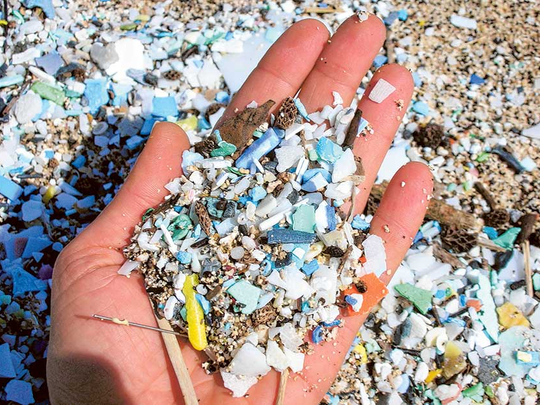
We weren’t looking for what we found.
My research group was trying to determine how much phosphorous was being carried by wind and rain into some of the most remote regions of the West [in the United States] and how this nutrient might affect lakes and streams. To do so, we sampled dust in 11 scattered locations, from Joshua Tree National Park in California to the Wind River Range in Wyoming.
Back at the lab, peering through microscopes at our samples, we could see pollen, insect parts and bits of minerals — all of which would have made it just another day in the life of a dust scientist. But what made it different was an unexpected interloper: tiny bits of plastic, most from synthetic microfibres used for making clothing. They were in all of our samples. And lots of them.
There was so much microplastic, we calculated that up to 6 per cent of the dusts in those far-flung locations are microplastics and that more than 1,000 metric tons are deposited in those places every year by wind and rain. Some blew in from nearby cities, but most came from much farther away and represented decades of plastic waste. Four colleagues and I recently published our findings in the journal Science.
Inhaled plastics can produce inflammation and lesions in lungs, and repeated exposure is suspected of leading to respiratory problems like asthma and cancer.
This waste has become so ubiquitous that it’s now in the air we breathe. Airborne microplastics don’t care what ZIP code you live in. Preventing a landfill in your community won’t limit your exposure. And there are still many questions. If dust in the Grand Canyon contains microplastics, how many of these tiny plastic particles are in city dust? How high will airborne concentrations of microplastics get? What effect are they having on the environment? Are microplastics more toxic than other, better-understood sources of air pollution such as natural and industrial dusts?
We know that inhaled plastics can produce inflammation and lesions in lungs, and repeated exposure is suspected of leading to respiratory problems like asthma and cancer. Inhaling microplastics may also increase exposure to other toxic substances and coatings associated with plastics and their manufacture.
Natural dust, which include dusts generated by humans, and industrial dusts can also contain dangerous components, like the pathogen Coccidioides, a soil-borne fungus that causes valley fever, which can produce flu-like symptoms. Industrial, urban and agricultural dusts often contain heavy metals as well as synthetic toxins. Outdoor air pollution causes roughly seven million premature deaths a year and is associated with pulmonary diseases, even when adjusted for underlying risk factors. Those statistics most likely include some of the effects of plastic. That we can breathe in microplastics has been known for decades. We just haven’t fully appreciated the scale of the problem.
Reducing plastic waste means taking aim at consumer comfort and convenience, and offering sustainable alternatives to plastics for those on all rungs of the economic ladder.
But as Steve Allen, who does research on microplastics at the University of Strathclyde in Glasgow, Scotland, put it recently to The Washington Post, “It is hard to imagine a sentence starting with: ‘The health benefits of breathing airborne microplastic .’”
We shouldn’t be surprised by these findings. In 2018, about 359 million metric tons of plastics were produced worldwide. Plastics are useful, of course, and we need them for medicine, food safety and technology. But do we really need plastic lawn decorations for every holiday? The plastic pollution crisis seems to have as much to do with industry as it does with consumer choices. A 2017 study in the journal Science Advances estimated that “if current production and waste management trends continue, roughly 12 billion metric tons of plastic waste will be in landfills or in the natural environment by 2050.”
Movements against plastics pollution have led to bans on plastic straws and plastic bags, and microbeads in cosmetics. But airborne microplastics mostly come from clothing, car tyres and the fragmentation of commodities and packaging used briefly and then thrown away, sometimes decades ago.
Reducing plastic waste means taking aim at consumer comfort and convenience, and offering sustainable alternatives to plastics for those on all rungs of the economic ladder.
The path forward to cleaning up this problem is not clear but undoubtedly will require sweeping and uncomfortable changes. Taking on this issue requires understanding it, and as our findings underscore, one thing is clear: We’re breathing in microplastics. That can’t be good.
— Janice Brahney is an assistant professor of watershed sciences at Utah State University, where she directs the Environmental Biogeochemistry and Paleolimnology Lab.








